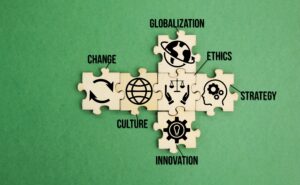The traditional concept of seeking a “culture fit” is undergoing a transformation. While alignment with organizational values is crucial, there’s a compelling case for redefining the approach. Instead of only pursuing individuals who seamlessly fit into an existing culture, the more modern approach focuses on the concept of “culture add.”
This paradigm recognizes the value of diverse perspectives and the richness that individuals with varied backgrounds bring to the table. In this article, we explore why embracing a “culture add” mindset is not just progressive but a strategic move that can significantly enhance the vitality and success of your organization.
 1. The Pitfalls of “Culture Fit”: Preserving Innovation and Creativity
1. The Pitfalls of “Culture Fit”: Preserving Innovation and Creativity
The relentless pursuit of a “culture fit” paradigm tends to create a very specific workplace environment. While on the surface this might give the impression of a tightly-knit and harmonious team, there is the potential to limit creativity and interrupt innovation. This consequence to “culture fit” is not merely theoretical; it is grounded in the exclusion of valuable perspectives that deviate from established norms and conventional expectations.
When organizations prioritize “culture fit” to the exclusion of diverse perspectives, they inadvertently limit the spectrum of ideas and approaches within their teams. Creativity thrives in environments where various viewpoints intersect, clash, and ultimately coalesce into groundbreaking solutions. However, a rigid adherence to a predetermined cultural mold can create an echo chamber of similar perspectives, stifling the very diversity that fuels creative thinking.
Innovation often emerges from the collision of different viewpoints and experiences. By constraining the diversity of thought and background, organizations risk missing out on unconventional ideas and alternative approaches that could be catalysts for transformative change.
This exclusivity also has cascading effects on the organization’s growth and adaptability. A workforce composed of individuals with a variety of backgrounds and perspectives is inherently better equipped to navigate unforeseen challenges and capitalize on emerging opportunities. Conversely, a homogeneous team, born out of an unwavering commitment to “culture fit,” may find itself ill-prepared to address the dynamic demands of a changing industry.
Resilience is not built on uniformity but on the capacity to learn, evolve, and thrive amidst uncertainty. Organizations that foster a culture of inclusion, where diverse perspectives are not only welcomed but celebrated, create an environment conducive to resilience.
 2. Embracing “Culture Add” for Organizational Enrichment: Fueling Innovation with Diverse Voices
2. Embracing “Culture Add” for Organizational Enrichment: Fueling Innovation with Diverse Voices
“Culture add” recognizes the inherent value that diversity, both in background and thought, brings to the fabric of an organization. Individuals regarded as a “culture add” represent a paradigm shift from conformity to the celebration of differences, acknowledging that such distinctions contribute immense value to the organization’s overall dynamics.
In this framework, individuals who are considered a “culture add” become catalysts for innovation and elevated collective intelligence within the team. The concept recognizes that a rich tapestry of backgrounds, experiences, and perspectives can infuse the organization with fresh ideas that challenge the status quo. These individuals bring a unique blend of skills, knowledge, and approaches, effectively serving as conduits for innovative thinking that transcends traditional boundaries.
Fresh ideas emanate from the intersection of diverse perspectives. When organizations actively seek individuals who are a “culture add,” they open the door to a wealth of creativity that arises from varied viewpoints. This diversity of thought not only fuels innovation but also ensures a more comprehensive and robust problem-solving capability within the team.
Unique approaches to challenges and opportunities are a direct outcome of a diverse workforce. Diverse experiences become a reservoir of insights, enabling the team to navigate complexities with agility and providing a competitive edge in an ever-evolving business landscape.
Moreover, the contribution of individuals who are a “culture add” extends beyond the individual level to elevate the collective intelligence of the entire team. This heightened collective intelligence not only enhances decision-making processes but also cultivates a culture of continuous learning and adaptability.
In essence, the concept of “culture add” transforms the recruitment and team-building process from a quest for conformity to a celebration of diversity. It recognizes that true organizational excellence is achieved not by seeking uniformity but by valuing and integrating differences. By actively seeking individuals who bring a fresh and diverse perspective, organizations position themselves to thrive in a dynamic and competitive landscape, where innovation and adaptability are key drivers of success. Embracing “culture add” is a strategic move that propels organizations toward sustained growth and excellence.
 3. Fostering Inclusivity and Employee Engagement: Building a Positive Work Culture
3. Fostering Inclusivity and Employee Engagement: Building a Positive Work Culture
An organization that places a premium on the concept of “culture add” actively celebrates the unique perspectives that individuals bring to the table. When an employee knows they are regarded as a whole person, there is a powerful sense of belonging and engagement that happens within the workplace.
By celebrating this diversity, there is an atmosphere where employees feel seen and valued. This acknowledgment goes a step further than mere acceptance, creating an environment where every person is an integral part of the collective whole.
The result is a positive work culture that permeates the organization. When individuals feel encouraged to bring their authentic selves to work, they are more likely to be motivated and engaged in their roles. Authenticity fosters a sense of transparency and honesty within the workplace, leading to stronger connections among team members. This openness promotes collaboration, as employees are more willing to share ideas and contribute to the collective success of the organization.
Moreover, an inclusive work culture enhances employee morale. When people feel appreciated for their unique contributions, they are more likely to be motivated to perform at their best. This motivation stems from a genuine sense of belonging, where individuals are not just employees but integral members of a diverse and dynamic team.
The sense of belonging and engagement within an inclusive organization transforms the workplace into a space where people are not just driven by personal success, but are also deeply invested in the collective success of the organization. Employees understand the interconnectedness of their efforts and the impact on the overall success of the company.
 4. Strategic Recruitment for Long-Term Success: Adapting to Industry Changes
4. Strategic Recruitment for Long-Term Success: Adapting to Industry Changes
Adopting a “culture add” mindset in building high performance teams represents a strategic evolution. It does not imply forsaking or compromising existing organizational values; rather, it signifies a nuanced understanding of how to enrich those values by strategically incorporating diverse perspectives. Recruiting with a “culture add” mentality involves seeking individuals who not only align with the core values of the organization but also bring new insights, experiences, and skills.
Hardly a departure from organizational values, this approach strengthens them by acknowledging that diversity and innovation are integral components of sustainable success. It’s about recognizing that a dynamic and forward-thinking organizational culture embraces change and evolution. The strategic recruitment process seeks individuals who not only fit within the existing value framework but also contribute something new and valuable that propels the organization toward achieving its objectives.
By strategically diversifying the talent pool, organizations position themselves for long-term success in a rapidly changing business landscape.
Here’s how:
Adaptability: An organization that values “culture add” understands that adaptability is a cornerstone of resilience. Recruiting individuals with diverse backgrounds and experiences ensures a workforce that is naturally adaptable to change. This adaptability is crucial for navigating shifting industry trends, technological advancements, and unexpected challenges. A diverse team is inherently more flexible and responsive, ready to pivot and innovate when necessary.
Innovation: Innovation arises from the intersection of different perspectives. By bringing in individuals who offer unique insights and approaches, organizations stimulate a culture of continuous innovation. A “culture add” mindset fosters an environment where employees are encouraged to think creatively, challenge the status quo, and contribute ideas that drive the organization forward. This commitment to innovation ensures that the organization remains at the forefront of industry developments.
Resilience: In the face of industry changes and external disruptions, having resilience is important. Strategic diversity in recruitment contributes to resilience by building a team that can weather uncertainties and emerge stronger. Diverse teams are better equipped to anticipate and adapt to challenges, drawing on a variety of experiences to find effective solutions. This resilience is a competitive advantage that allows the organization to thrive even in turbulent times.
Cultural Enrichment: Rather than diluting organizational values, a “culture add” approach enriches them. It brings depth to the cultural tapestry by incorporating new perspectives that align with the overarching mission and values. This cultural enrichment fosters a vibrant and inclusive workplace where employees feel valued for their unique contributions, further solidifying the organizational identity.
Recruiting with a “culture add” mindset represents a strategic investment in the present day and the future. It’s a commitment to organizational values while recognizing that diversity and innovation are essential for long-term success. By strategically diversifying the workforce, organizations position themselves not only to adapt to change but to proactively shape and lead in a dynamic and evolving business landscape.
Conclusion: Embrace the Future with “Culture Add”: Sustained Success in a Changing Landscape
It’s time to rethink the traditional notion of “culture fit” and embrace the progressive concept of “culture add.” By prioritizing diversity of thought and experience, organizations can create a workplace that thrives on innovation, adaptability, and inclusivity. It’s a shift that not only enriches the organizational culture but also positions your company for sustained success in an ever-evolving business landscape.
Not embracing a “culture add” mindset include missed opportunities, decreased innovation, diminished employee engagement, and a diminished ability to navigate industry changes effectively. Now’s the time to stop trying to force a perfect “culture fit” and start welcoming in “culture add” to advance your organization into uninterrupted creativity and innovation.

